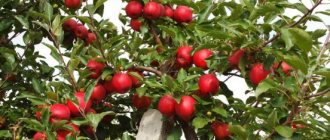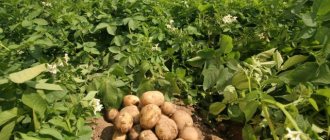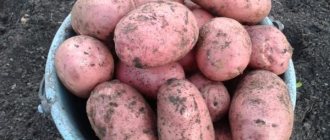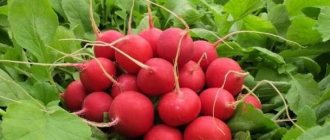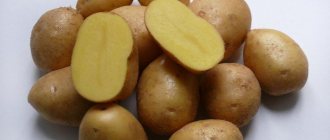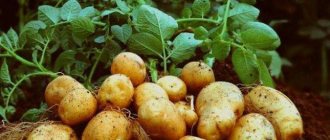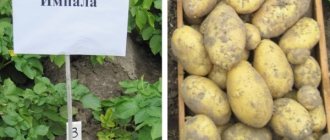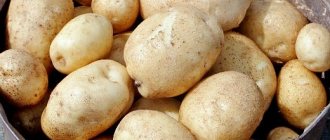Description of the variety
One of the serious advantages of the crop is its early maturation. In this regard, the Gala potato, again, stands out from other varieties. Description of the variety will not take up much space. The bush is semi-erect or spreading, the type is intermediate. The bushes and leaves are usually medium in size, and the flower corollas are white.
The peel and pulp have a pleasant yellow color, the shape of the tuber is round or oval, and the eyes are small. The potential yield is high - about 60 tons per hectare. One bush can contain from 16 to 20 tubers with an average weight of 80 to 130 grams.
The starch content is up to 13%. This is relatively little, and those who strive for a healthy diet should eat Gala potatoes. Reviews of the boiliness characterize it as good, and the taste is rated 9 points out of 10. The protein content ranges from 3 to 3.5%, and vitamin C - up to 12 mg per 100 grams of product.
This potato variety retains all its qualities well and for a long time during storage. In addition, it is very resistant to various diseases, such as potato cancer, nematode, late blight, scab and various viral diseases. This is a table variety and is well preserved in packaging.
Taste qualities
Gala is a table potato variety. The tubers' low starch content means they are better suited for boiling rather than frying. When boiled, potatoes retain their integrity, while becoming tender and crumbly, making them equally good for making mashed potatoes, as well as for soups or salads. In addition, Gala can be successfully baked. Experts define the taste qualities of the tubers, which have delicate, light-yellow flesh, as very high: the tasting rating of root vegetables on a ten-point scale, according to various sources, ranges from 8 to 9.
Potato variety Gala. Customer Reviews
Gala potatoes are the top sellers of 2013. The reason for this is the huge number of positive consumer reviews, which they willingly share with each other in comments, on blogs and forums. Here are a few benefits of this variety that are often mentioned:
- the Gala variety is relatively easy to grow due to its disease resistance;
- when all necessary operations of the agrotechnical plan are carried out, its potential yield is very high and amounts to 70 tons per hectare, while marketability is maintained by 90%;
- fairly rapid ripening, which requires approximately 2.5 months;
- Gala potato tubers are unusually smooth, with shallow eyes, which allows the use of machine peeling, for the same reason it is easy to wash and package;
- This variety is resistant to damage, which makes it possible to carry out mechanical harvesting and sorting.
And, of course, the most important thing that consumers usually report first is taste. Here again the Gala potato variety is in the lead. The characterization of gourmets who gave it nine out of ten is no joke! Dishes made from it are certainly appreciated! That is why, according to the sales results in 2013, the main positions are again occupied by Gala potatoes. The photo below gives an idea of its appearance.
Soils and fertilizing
Gala potatoes are not picky about the type of soil; it can be cultivated even on sandy and sandy loam soils, but attention should be paid to the balance of nutrients and fertilizers. It is recommended to apply fertilizers to the hole during planting and to frequently water the entrances during the planting of root crops. The second feeding should be carried out 40-45 days after planting along with watering.
You can use organic or mineral fertilizers for fertilizing. If you use manure, then only rotted material should be added to the hole in a volume of 200-250 g per bush. When fertilizing with chicken manure, it should be pre-soaked in the proportions of 1 part manure to 15 parts water. About 1 liter of solution is poured under the tuber.
This variety responds positively to the application of mineral fertilizer complexes based on nitrogen compounds during the period of plant development and based on sulfates during the period of formation and ripening of tubers.
The second feeding of the Gala variety is carried out after the first hilling, but not earlier than 40 days after planting. At this time, potatoes are preparing for flowering and laying young tubers, which means they need potassium and phosphorus. Fertilizers of potassium sulfate, superphosphate, as well as an infusion of wood ash or ammonium nitrate are used as top dressing.
Attention! Hilling potatoes should not be carried out in dry and hot weather. Dry soil in the process injures the root system of the plant and the developing fruits, which can lead to defects in the appearance of the potato, as well as to the death of the bush.
It is during this period that preventive measures against fungal diseases of potatoes should be taken, which will improve the quality of storage of ripened tubers and will preserve the health of the soil.
What are the benefits of Gala potatoes?
100 grams of this variety contains 500 mg of potassium. In this regard, neither bread, nor meat, nor fish can compare with it. But this microelement strengthens the heart muscle and prevents the development of sclerosis.
In addition, potatoes are a dietary product for heart and kidney diseases. For peptic ulcers of the stomach and duodenum, the raw juice of this vegetable helps well. The Gala potato variety is perfect for these purposes. The results of those who have tried this method on themselves are impressive.
This potato is able to restore metabolism by neutralizing excess acids, which cause the body to age prematurely. The acetylcholine it contains reduces blood pressure.
Gala potatoes can also be successfully used for burns and skin diseases, headaches and poisoning. Probably everyone in childhood was treated for a cold with steam from boiled potato peels. It can also be used for warming up for radiculitis.
This vegetable is similar to bread in its chemical composition, and in the composition of vitamins (E, K, PP, B, folic acid) and minerals - to greens. Moreover, its calorie content exceeds that of other plants by 3 times (800-900 kcal).
As you know, the protein tuberin contains absolutely all the amino acids that the human body needs, and it is one of the components of this potato variety. A description of the percentages of the daily value of vitamins and minerals contained in one serving of the product is given in the table:
| A | 0,3 | Cl | 2,5 |
| B1 | 8 | S | 3,2 |
| B2 | 3,9 | Cu | 14 |
| B5 | 6 | Mn | 8,5 |
| B6 | 15 | Cr | 20 |
| C | 22,2 | V | 373 |
| PP | 9 | Zn | 3 |
| Na | 0,4 | Fe | 5 |
| K | 22,7 | Bor | 5,8 |
| Ph | 7,2 | Co | 50 |
Especially a lot of nutrients are contained under the skin of the tubers, but it is there that harmful pesticides and nitrates are collected.
You should also avoid eating tubers that have turned green. They are unsuitable even for animals, only for seeds.
Reviews
Potatoes “Gala” have collected a lot of both positive and negative reviews, but there are many more positive ones. The main complaints and praises of farmers.
★★★★★
Vitaly, Rostov region. I tried to plant "Gala".
I am pleased that the variety is mid-early, disease-resistant and quite tasty. Even in the dry months there is a good harvest, although in the rainy months it is quite good. Stored well. ★★★★★
Vladimir, Stavropol region. These potatoes store well and are easy to peel.
The downside is that it has no taste, is a bit dry and overcooked. I bought it on the advice of my neighbors, but I'm not very happy with it. ★★★★★
Valeria, Vladimir region. I paid attention to “Gala” because it is not starchy and I don’t like it when it boils too much.
But the potatoes are very dry. I tried to fry it - it turned into porridge, I cooked it - it was dry, no matter how much oil I put in. A little undercooked, it actually resembles glass. Like fries, they consume a lot of oil, but remain dry. Maybe it's good for soup. ★★★★★
Peter, Voronezh region. I liked Gala.
Tasty and plentiful. I can’t point out any downsides, it’s a very productive variety, I pick up to 20 potatoes from a bush, once there were even 40. True, it’s capricious, it loves watering, warmth and fertilizers, without them you’ll only get small tubers. Harvesting is best done in October. I think many people should try it. ★★★★★
Anna, Kirov region. I bought “Gala” as an early variety, but I got the impression that it was a late variety.
If you generously fertilize and water it, it will ripen earlier, but I’m not a fan of adding chemicals. But I liked the taste. Hide
Add your review
"Gala" is one of the earliest ripening potato varieties. The full ripening period ranges from 60 to 80 days, from the moment the seeds are planted in the ground. Thanks to its abilities, this potato is an ideal choice for those who want to grow this crop in the middle zone.
0
0
Copy link
Views of summer residents
The Gala variety is in wide demand among the population. It is readily bought and also grown in private plots. Fans of country farming speak about it with delight.
For a long time now, everyone has been dreaming of a potato variety that would have the best qualities and at the same time be unpretentious. Potato Gala is the embodiment of the aspirations of many. It tolerates heat well, does not suffer in the absence of moisture, tolerates insect attacks without much loss, and quickly copes with diseases.
Growers say that Gala potatoes are needed to achieve high yields with little effort. Reviews about its taste complement the list of advantages of the variety.
On forums for home gardening enthusiasts, summer residents share tips on growing this variety. Gala loves to be moisturized evenly. It germinates well and is cultivated under the cover of film, so it can be prepared for planting in advance. This is important for an early hybrid, and this potato is precisely a mid-early variety.
Excellent taste and beautiful appearance of the tubers primarily characterize Gala potatoes. Consumer reviews also report its excellent keeping quality. It is not surprising that its popularity among the population is rapidly increasing.
Advantages and disadvantages
Pros:
- productivity;
- early ripening harvests (uniform, marketable);
- adaptability to different climates;
- unpretentiousness to the soil;
- low susceptibility to viruses (no need for preventive treatment);
- transportability;
- marketability and consumer qualities;
- cold resistance and drought resistance.
Minuses:
- It is undesirable to delay the harvesting time (commodity quality deteriorates);
- danger of late blight infection (during epidemics, frequent precipitation).
“Favorite” disease of the Gala variety
The Gala potato variety causes the least number of problems when growing. Reviews say that perhaps its most vulnerable point is its susceptibility to a disease such as rhizoctonia, which is caused by a fungus.
Roots, stems, and sprouts suffer from this disease. On tubers it looks like dark lumps of high density, and on sprouts it looks like brown sores. Gradually they destroy the sprouts as they grow. This disease often affects the Gala potato variety. The photo below clearly illustrates the manifestations of the disease.
Potatoes infected with this fungus wilt and lag behind in development. Typically, infection occurs through the soil, but sometimes diseased tubers also act as a carrier of the disease. Rhizoctonia, if not controlled, can reduce the yield by 15-20%.
Diseases and pests
Gala is not afraid of most diseases and pests that are relevant to potatoes, although sometimes precedents do occur. A separate advantage is the high resistance of the variety to the Colorado potato beetle. The most common diseases and pests are listed below.
Rhizoctoniosis
The disease manifests itself in the form of black or brown ulcers, which subsequently die off. Leaves begin to curl and stems die. Before planting, young individuals are treated with special preparations. If a problem occurs, they use products such as Baktofit, Maxim, and so on. For prevention, it is important to harvest the crop on time, process the crop and responsibly select planting material.
Late blight
Brown spots appear on the leaves. The reverse side is covered with a white coating. If you cut a tuber, you can see the so-called “rust”. To combat the disease, spray the tops with Bravo, Shirlan, Acrobat, Thanos. For the purpose of prevention, tubers are germinated and planting material is treated before planting.
Dry spotting
Dark brown spots appear, which quickly increase in size, merging together. For treatment, tubers are treated before planting using Agat-25, Baktofit, Bravo. Once every couple of weeks, when the disease manifests itself, spray with Profit. For prevention, the watering regime is carefully observed, especially if the weather is hot, and fed with nitrogen-containing fertilizers.
Brown bacterial rot
The leaves wrinkle and turn yellow en masse. To prevent pathology from occurring, treatment is carried out before planting using Planriz. For the purpose of prevention, potatoes are planted as far as possible from nightshades and try not to damage the tubers during harvesting.
Mosaic disease
Flowering disappears, the growing season decreases. There are no treatment methods yet, so any contaminated material is immediately removed and burned. Most likely, healthy bushes that were located next to diseased plants will have to be destroyed.
Click beetle larva
The crop is attacked by yellow-orange worms, they gnaw the tubers. Traps, spraying using Hurricane Forte, and “distractive” plantings are effective. For prevention, it is important to constantly dig the soil as deep as possible.
Potato moth
The caterpillars eat the plant and pollute it with their waste. To get rid of the pest, Karbofos is used.
Medvedka
Insects make tunnels in the ground, gnawing roots. To combat mole crickets, traps and watering with Karbofos are used.
To keep Gala potatoes healthy
It is important to ensure that the following conditions are met:
- There should be no crust on the soil for planting.
- It is better that the soil is warm when planting.
- Pre-treat the potatoes with a solution of boric acid. A borax solution at a concentration of 1.5% is also suitable.
- Spraying with Zircon when sprouts appear (0.3 ml per bucket is enough) protects well from infection.
If infection does occur, it is necessary to treat the potatoes with the Kuproksat fungicide at the rate of 25-50 grams per bucket of water. It is recommended to repeat this procedure after 10 days. Do not forget that you should not use chemicals 3 weeks before harvest!
Tubers and yield
Productivity is high. Ripening time is 65-70 days. When harvesting, you can collect about 20 tubers from each bush. Potatoes are small in size, weighing up to 120 g. The shape is round, sometimes oval. The color of the tubers is light and uniform. Length 8-9 cm, width 5-6 cm.
Sources
- https://OgorodGuru.com/ovoshhi/kartofel-gala
- https://kartofell.ru/kartofel-gala/
- https://fermer.blog/bok/ogorod/kartofel/sorta-kartofelya/sredneranniy-kartofel/2569-sort-kartofelja-gala.html
- https://kursi-floristiki.ru/ovoshchi/gala-kartofel-harakteristika.html
- https://wiki-dacha.ru/sort-kartofelya-gala
- https://ogorodum.ru/kartofel-gala-opisanie-sorta-foto-i-otzyvy.html
- https://VesOgorod.ru/kartofel-gala/
[collapse]
Potato Gala - a product of selection
This potato variety was developed as a result of selective breeding. In modern Germany, new varieties of potatoes are systematically developed (a description of each is drawn up in great detail). The development of breeding in this country began around the middle of the 19th century. Today, 35 private enterprises are engaged in this.
This work is mainly carried out in the Baltic regions of Germany. The state provides financial support to the gene bank, pays for research, and develops equipment.
There is a special structure - the Federal Department, which is responsible for the protection of new plant varieties. It controls the results of the work of breeders, sets standards, and classifies the results.
Serious attention is paid to phytosanitary testing, the resistance of potatoes to various diseases is determined, as well as its taste and culinary qualities, and the most suitable processing methods.
As a result, the new variety receives a license, which gives the right to conduct further tests. At the next stage of testing, the suitability of cultivating the variety in a particular area is determined.
Gala potatoes also passed all the necessary stages of inspection here. The description of the variety and all its advantages allowed it to enter the top ten leading potato varieties, which occupy 35% of the area allocated for this crop. The preferences are due to the fact that there is practically no market requirement that Gala potatoes do not meet. The characteristics of its main qualities are literally amazing in their perfection.
Certified potato seed from Germany is very popular. The main exporters are the Mediterranean countries, as well as Austria and Russia.
Crop rotation rules
Crop rotation is the alternation of different crops grown year after year in the same bed, which ensures the achievement of maximum yields.
This result is possible due to the fact that the replacement of plants with similar developmental characteristics does not allow increasing the population of pests remaining in the soil that parasitize certain crops, as well as critically reducing certain mineral substances in it, to which such crops are especially demanding.
Moreover, there are plants that secrete substances during their life processes that are toxic to their “host”, but at the same time very useful for other crops. Knowing these rules allows you to determine good and bad predecessors for each plant.
Did you know? French fries, like many other world-famous dishes, were invented by accident, and not thanks to the culinary talent, but rather in spite of it. In 1853, the chef of one of the American restaurants, George Crum, got angry with a picky visitor who complained about fried potatoes cut too thick, cut the vegetable into the thinnest slices and, after frying, served it to the brawler, which unexpectedly delighted him.
For potatoes (regardless of variety) they are:
- Good predecessors:
- Green manure;
- Oats;
- Cucumbers;
- Zucchini;
- Pumpkin;
- Cabbage;
- Onion;
- Beet;
- Carrot;
- Garlic;
- Beans;
- Peas;
- Lentils.
- Bad predecessors:
- Potato;
- Tomatoes;
- Bell pepper;
- Hot pepper;
- Eggplant;
- Tobacco;
- Physalis;
- Sorghum;
- Sunflower.
How to plant these potatoes?
When planting Gala potatoes, it is advisable to select specimens no larger than the size of a chicken egg. It’s good if you can warm them up in the sun 3-4 days before planting. Leave the distance between the tubers 80 cm, and the depth should not exceed half the palm.
In order to ensure good growth of the root system, it is necessary to sprinkle the emerging sprouts with soil several times. And so that the land has time to rest well during the winter, you can sow rye in place of planting potatoes.
An important advantage of the Gala potato is that it can be grown on any type of soil, and even get a rich harvest. The main thing is proper care.
In order for these potatoes to lie for a long time, until spring, remaining in excellent condition, it is necessary to remove the tops about two weeks before starting to dig them up.
Planting, cultivation and care
Let's look at the features of caring for Gala potatoes. What's important here is:
- carefully prepare planting material;
- choose the right time for planting;
- during the growing season, water and fertilize;
- fight pests and diseases if they arise.
Preparing Potatoes
Tubers should be properly prepared before planting. When using purchased seed material, there is no need for preparation, since it is already prepared for planting by the manufacturer.
Independent preparation of tubers consists of the following steps:
- Selection of seed material . Choose only healthy, undamaged tubers. The size of the potatoes should not exceed 3 cm in diameter.
- Warming up the seeds . 3 days before planting potatoes, the seed material is removed from the storage area and warmed up in the sun.
- Treatment of tubers with insecticides and growth stimulants . This will allow the plants to get a quick start after planting and protect the potatoes from wireworms and other pests.
Planting dates and scheme
Since weather conditions in different regions of Russia are not the same, spring comes at different times from year to year, it is difficult to determine the exact planting time. In some regions, you can start planting at the end of April; in other areas you have to wait until the soil warms up and warm weather sets in.
After waiting until the soil at a depth of 10 cm warms up to +12 degrees, you can begin planting.
It is better to plant according to a 70 by 50 cm pattern, deepening the planting material 10-13 cm into the soil.
Agricultural technology
The technology for cultivating Gala potatoes is not much different from growing other varieties. The list of activities for growing potatoes should include:
- Irrigation . The variety does not tolerate waterlogging, so it should be watered sparingly. First watering, spending up to 2 liters of water on each hole. Next, you should regularly water the seedlings at the rate of 1.5 liters per bush. In hot weather, there should be more watering than in cloudy weather. Some summer residents install drip irrigation on their potato plots, which saves irrigation water and eliminates the risk of soil overmoistening.
- Hilling up . Thanks to this agricultural technique, the volume of the root system increases. This affects the increase in crop productivity. The essence of hilling bushes is to push the soil into the root zone of the bush.
- Fertilizers . To get a large harvest of tubers, you will need to maintain a fertilizer system. In the fall, when digging up the future potato plot, you should add 6 kg of humus and 15 g of potassium sulfate for each 1 m². In the spring, before planting, fertilizer is again applied to the site in the form of compost at the rate of 4 kg per m², as well as 30 g of nitrophoska, 20 g of potassium sulfate, 20 g of ammonium nitrate.
- Preventive treatments . During the growing season, several preventive treatments should be performed against the Colorado potato beetle and a number of diseases, using popular insecticides and fungicides.
- Tops trimming . It is recommended to mow the tops 8-10 days before the planned harvesting of tubers. After such an agricultural practice, harvesting the crop is simplified. This also allows you to extend the shelf life of tubers.
Disease and pest control
The originator stated that the Gala variety is endowed with excellent resistance to mechanical injuries to tubers, attacks by the Colorado potato beetle, and a large list of fungal, viral and bacterial diseases.
However, in practice, potatoes can suffer from pests and diseases. Therefore, during the season, gardeners carry out preventive spraying.
The following drugs are used against pests:
- Aktara;
- Corado;
- Regent;
- Prestige.
Fungicides that can be used are:
- Kuprosat;
- HOM;
- copper oxychloride.
If we analyze the reviews of gardeners who grew this variety, it turns out that Gala is easy to care for, gives decent yields on any soil and in any regions of Russia, ripens early and its tubers are well stored. After 70 days of growing season, you can begin harvesting.
Some care features
The Gala variety produces good, friendly shoots; the tops in the rows close quickly, while growing moderately. This variety is best suited for a second planting with last year's seeds. One of the features of the Gala variety is multi-tuberism, and the tubers are aligned (45-55 mm).
When growing all varieties bred abroad, you can count on a decent harvest only if you use good agricultural technology. However, it is not that difficult.
During the second hilling, it is enough to feed the plants with complex fertilizers at the rate of 1 tablespoon of azofoska per 4 potato bushes. And, of course, add fertilizer before planting. This is quite enough to get an excellent harvest.
Planting methods and schemes
Gardeners practice several methods of planting potatoes, among which there are two effective traditional ones:
- planting in a hole;
- row seating.
In both cases the same rules apply:
- the depth should correspond to the limits of 5-8 cm;
- the distance between seeds in one row should not exceed 30 cm;
- The distance between rows should not be less than 60-70 cm.
The description of the potato planting process is as follows:
- the future row is marked with pegs with a cord stretched between them, or an approximate furrow is made in the ground;
- prepare the recesses;
- if necessary, place ash, chalk or organic fertilizers in the pits;
- carefully place the potato tuber with the sprout facing up;
- watered and buried.
Advice. When the entire planting area is filled with tubers, the surface is leveled with a rake, breaking up large clods of earth.
How to protect Gala potatoes from viruses?
Typically, the variety bears fruit well for six years. However, some viruses can make adjustments to the lifespan of potatoes. If an ordinary, non-elite variety of potato is grown in neighboring areas, then viruses may well get into your beds from this land along with aphids. To prevent this from happening, you need to do the following:
- It is necessary to carefully examine all the bushes when the plants reach 10-15 cm in height, and note those that have curled leaves. Their tubers can be cooked as food, but cannot be used for seeds.
- Plants with viruses have fewer tubers, so only those bushes with high yields should be left for seeds.
If you follow these simple conditions, you can significantly extend the life of the variety.
One of the recipes for Gala potatoes
Of course, any potato dish is suitable for this variety. It is believed that it is especially good when boiled in “pieces”, since it has the ability to retain its shape during cooking without becoming overcooked.
However, Gala potatoes (reviews say so), baked in the oven in the “grill” mode, are simply magnificent! In addition, this is a very healthy low-calorie quick recipe for those who want to maintain their figure:
- first of all, you need to peel the potatoes and cut them into cubes;
- then place in a bowl, add salt to taste, sprinkle with natural Italian herbs seasoning (can be replaced if desired);
- add vegetable oil at the rate of one tablespoon per 0.5-1 kg of potatoes and mix well so that a thin layer of oil covers all the potatoes;
- Place on a baking sheet and place in a preheated oven.
Bake in grill mode at 190° for 15 minutes. If you want softer potatoes, you can lightly sprinkle the baking sheet with water. A dish decorated with fresh herbs will look more appetizing.
Harvesting and storage
When planting Gala in early May, at the end of July you can taste the first harvest. The main harvest begins in late summer - early autumn. After digging, the dug potatoes are sorted and only healthy fruits, without signs of rot, are selected for storage. The tubers are immediately sorted according to their intended purpose, which will be used for cooking and which for planting next year.
You can store potatoes in any cool place at a temperature no higher than 10 degrees Celsius. At higher temperatures, potatoes begin to sprout and lose their hardness.
On a note! Before harvesting for storage, potatoes should never be washed; the tubers must be dry.
